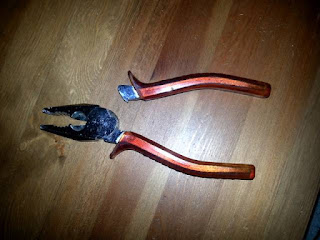 |
| Particle colliding with an obstacle. |
N = 256;
[x y] = meshgrid(linspace(-1, 1, N), linspace(-1, 1, N));psi = exp(-10*((x+0.5).^2 + (y+0.5).^2)).*exp(-j*(-50*x -50*y));
psi = psi/norm(psi);
V = zeros(N, N);
V(N/2-20:N/2-10, N/2:N/2+20) = 1;
V(N/2+10:N/2+20, N/2-10:N/2+10) = 1;
S = conv2(diff([0 0 1 0 0], 2), eye(N)); % del2 matrix form
for n = 1:N % H = V - del2
Ex{n} = expm(-j*(diag(V(n, :)) - S(:, 2:end-1)));
Ey{n} = expm(-j*(diag(V(:, n)) - S(:, 2:end-1)));
end
for t = 0:150 % time evolution psi(t+1) = psi(t)*exp(-j*H)
for n = 1:N
psi(:, n) = Ex{n}*psi(:, n);
end
for n = 1:N
psi(n, :) = psi(n, :)*Ey{n};
end
A = abs(psi).^2/4.5e-4;
cla; imagesc(A); caxis([0 1]); truesize; drawnow;
imwrite(imresize(A, 0.5), ['png/' num2str(t+1, '%04.f') '.png']);
% ffmpeg -r 30 -f image2 -i %04d.png -vcodec libx264 -crf 25 -pix_fmt yuv420p test.mp4
% convert -resize 50% -layers Optimize -delay 3 *.png test.gif
end
 |
| Three particles scattering, simplified approximate solution only. |
[x y] = meshgrid(linspace(-1, 1, N), linspace(-1, 1, N));
A = 1.4; B = -0.2; C = 1.2;
psi{1} = exp(-50*((x-0.5*A-B).^2 + (y-0.4*A).^2)).*exp(-j*( 20*x*C + 10*y*C));
psi{2} = exp(-50*((x+0.2*A-B).^2 + (y+0.3*A).^2)).*exp(-j*(-20*x*C - 10*y*C));
psi{3} = exp(-50*((x-0.4*A-B).^2 + (y+0.3*A).^2)).*exp(-j*( 10*x*C - 20*y*C));
v = fft2(0.3./(x.^2+y.^2+0.01));
for x = 1:3
psi{x} = psi{x}/norm(psi{x});
end
in = 1;
for t = 0:15000
if mod(t, 150)==0
B = 0;
for x = 1:3
A = abs(psi{x}).^2;
B = B + A/max(max(A));
end
figure(1); cla; imagesc(imresize(B, 4)); truesize; drawnow;
imwrite(B, ['png/' num2str(in, '%04.f') '.png']);
in = in + 1
end
for x = 1:3 % fast 2D convolution with fft
V{x} = fftshift(ifft2(v.*fft2(conj(psi{x}).*psi{x})));
end
for x = 1:3 % separate wave functions
W = zeros(N, N);
for y = 1:3
if y~=x
W = W + V{y};
end
end
psi{x} = psi{x} + 1e-3*j*(4*del2(psi{x}) - W.*psi{x});
end
end
/* gcc test.c -lGL -lSDL */
#include <GL/gl.h>
#include <SDL/SDL.h>
char *d =
"float t = gl_Color.x*1000.;"
"vec3 scene(vec2 p) {"
" float z = 5.;"
" mat3 X = mat3(1., 0., 0., 0., cos(2.*t), sin(2.*t), 0., -sin(2.*t), cos(2.*t));"
" mat3 Y = mat3(cos(3.*t), 0., -sin(3.*t), 0., 1., 0., sin(3.*t), 0., cos(3.*t));"
" vec3 c = X*Y*vec3(1.5*cos(.5*5.*t), 1.5*sin(.5*7.*t), 7.);"
" while(z<10.) {"
" vec3 r = X*Y*(vec3(sqrt(z)*p.x, sqrt(z)*p.y, z));"
" if(abs(r.x-c.x)<.8 && abs(r.y-c.y)<.8 && abs(r.z-c.z)<.8) return r;"
" if(distance(r, c)<1.) return r;"
" z += .05;"
" }"
" return vec3(10.);"
"}"
"void main() {"
" gl_FragColor = vec4(0.);"
" vec2 p = vec2(gl_FragCoord.x/256.-1., gl_FragCoord.y/256.-1.);"
" vec3 q = scene(p);"
" if(length(q)<10.) {"
" vec3 dx = scene(vec2(p.x + .05, p.y)) - scene(vec2(p.x - .05, p.y));"
" vec3 dy = scene(vec2(p.x, p.y + .05)) - scene(vec2(p.x, p.y - .05));"
" float a = 1.5*dot(normalize(cross(dx, dy)), normalize(q))/sqrt(length(q));"
" gl_FragColor = vec4(a);"
" }"
"}";
main(c) {
SDL_Event e;
SDL_SetVideoMode(512, 512, 0, SDL_OPENGL);
glUseProgram(glCreateShaderProgramv(GL_FRAGMENT_SHADER, 1, &d));
/*
c = 0;
GLubyte **pixels = malloc(3*512*512);
int cur;
char filename[80];
*/
while(e.type!=SDL_QUIT) {
glColor3us(c++, 0, 0);
glRecti(-1, -1, 1, 1);
SDL_GL_SwapBuffers();
SDL_PollEvent(&e);
/*
sprintf(filename, "%04d.ppm", c);
FILE *f = fopen(filename, "w");
fprintf(f, "P3\n%d %d\n%d\n", 512, 512, 255);
*pixels = realloc(*pixels, 3*512*512);
glReadPixels(0, 0, 512, 512, GL_RGB, GL_UNSIGNED_BYTE, *pixels);
for(int i=0; i<512; i++) {
for(int j=0; j<512; j++) {
cur = 3*((512-i-1)*512+j);
fprintf(f, "%3d %3d %3d ", (*pixels)[cur], (*pixels)[cur+1], (*pixels)[cur+2]);
}
fprintf(f, "\n");
}
*/
}}
 |
| Zoom into the Julia set (one of them). |
N = 256; B = 0.75;
X = linspace(-1, 1, N);Y = linspace(-1, 1, N);
while true
B = B*sqrt(sqrt(0.75))
y0 = 0.636;
x0 = 0.107;
X = linspace(x0-B, x0+B, N);
Y = linspace(y0-B, y0+B, N);
for y = 1:N
for x = 1:N
% z = 0.0; % Mandelbrot
% z0 = X(x) + Y(y)*j; % Mandelbrot
z = X(x) + Y(y)*j; % Julia
z0 = 0.5 + 0.5*j; % Julia
iteration = 0;
while abs(z) < 2 && iteration < 128
z = z^2 + z0;
iteration = iteration + 1;
end
s(x, y) = log(iteration);
end
end
end
#include <stdio.h>
#include <math.h>
main() {
char filename[80];
int N = 128, x, y, c=1;
float f[128*128]; float p[128*128];
float u[128*128]; float v[128*128];
float ux[128*128]; float vx[128*128];
float uy[128*128]; float vy[128*128];
float u2[128*128]; float v2[128*128];
float us[128*128]; float vs[128*128];
float px[128*128]; float py[128*128];
for(x=0; x<128*128; x++) {
f[x] = 0.0; p[x] = 0.0;
u[x] = 0.0; v[x] = 0.0;
ux[x] = 0.0; vx[x] = 0.0;
uy[x] = 0.0; vy[x] = 0.0;
u2[x] = 0.0; v2[x] = 0.0;
us[x] = 0.0; vs[x] = 0.0;
px[x] = 0.0; py[x] = 0.0; }
for(int t=0; t<4500; t++) {
for(y=-5; y<5; y++)
for(x=-5; x<5; x++) {
u[(int)(0.75*N+x)+(N/2+y)*N] = 0.15;
v[(int)(0.75*N+x)+(N/2+y)*N] = 0.0;
}
for(y=1; y<N-1; y++)
for(x=1; x<N-1; x++) {
ux[x+y*N] = 0.50*(u[(x+1)+y*N] - u[(x-1)+y*N]);
vx[x+y*N] = 0.50*(v[(x+1)+y*N] - v[(x-1)+y*N]);
uy[x+y*N] = 0.50*(u[x+(y+1)*N] - u[x+(y-1)*N]);
vy[x+y*N] = 0.50*(v[x+(y+1)*N] - v[x+(y-1)*N]);
u2[x+y*N] = 0.25*(u[(x+1)+y*N] - 2.0*u[x+y*N] + u[(x-1)+y*N]);
v2[x+y*N] = 0.25*(v[(x+1)+y*N] - 2.0*v[x+y*N] + v[(x-1)+y*N]);
u2[x+y*N]+= 0.25*(u[x+(y+1)*N] - 2.0*u[x+y*N] + u[x+(y-1)*N]);
v2[x+y*N]+= 0.25*(v[x+(y+1)*N] - 2.0*v[x+y*N] + v[x+(y-1)*N]);
}
for(x=0; x<N*N; x++) {
us[x] = u[x] + u[x]*ux[x] + v[x]*uy[x] + u2[x]/20.0 - px[x]/20.0 + 0.00000;
vs[x] = v[x] + u[x]*vx[x] + v[x]*vy[x] + v2[x]/20.0 - py[x]/20.0 - 0.00005;
}
for(y=1; y<N-1; y++)
for(x=1; x<N-1; x++) {
f[x+y*N] = 0.5*(us[(x+1)+y*N] - us[(x-1)+y*N] + vs[x+(y+1)*N] - vs[x+(y-1)*N]);
p[x+y*N] = 0.25*(p[(x+1)+y*N] + p[x+(y+1)*N] + p[(x-1)+y*N] + p[x+(y-1)*N] - f[x+y*N]);
}
for(y=1; y<N-1; y++)
for(x=1; x<N-1; x++) {
px[x+y*N] = 0.5*(p[(x+1)+y*N] - p[(x-1)+y*N]);
py[x+y*N] = 0.5*(p[x+(y+1)*N] - p[x+(y-1)*N]);
u[x+y*N] = us[x+y*N] - px[x+y*N];
v[x+y*N] = vs[x+y*N] - py[x+y*N];
}
if(t%40==0) {
printf("%d\n", t);
sprintf(filename, "ppm/%04d.pgm", c);
FILE *f = fopen(filename, "w");
fprintf(f, "P2\n%d %d\n%d\n", 128, 128, 255);
c++;
for(int j=0; j<128; j++) {
for(int i=0; i<128; i++) {
float val = 1500.0*sqrt( u[i+j*N]*u[i+j*N] + v[i+j*N]*v[i+j*N]);
if(val>255.0) val=255.0;
fprintf(f, "%3d ", (unsigned char)val);
}
fprintf(f, "\n");
}
close(f);
}
}
}







